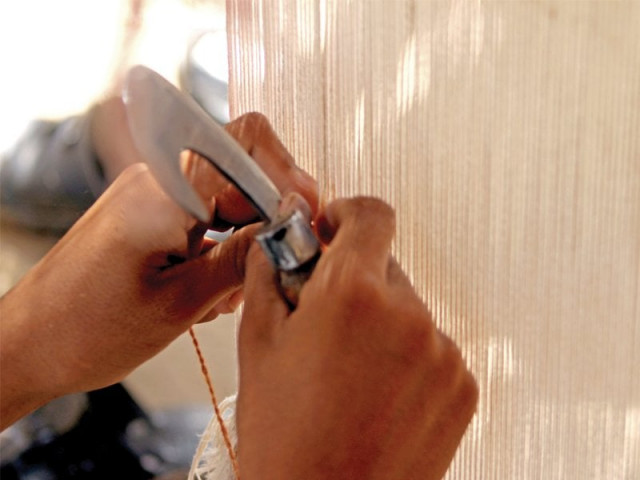At the khaddi: Weaving yarn instead of dreams
The child carpet-weavers of Tharparkar are exploited at the hands of middlemen and suffer from health hazards.

The child carpet-weavers of Tharparkar continue to be exploited at the hands of middlemen and suffer from health hazards. DESIGN: MAHA HAIDER
Their cheeks are flushed. They whisper in hushed tones and giggle away at a tightly guarded-secret. Reshma and Marvi look like teenage girls anywhere. Only, they are not.
On a sweltering summer afternoon, sitting behind a wooden khaddi (carpet-weaving loom) in a remote village called Maghoo Bheel in Tharparkar, their fingers moving dexterously to a silent rhythm, they are one of the nearly 140,000 child carpet weavers in Pakistan (Source: Federal Bureau of Statistics, 2001). The sisters work six to eight hours each day turning yarns of richly coloured wool into intricately designed carpets that will grace lavish rooms in cities far beyond their reach.
“Where are you from?” Marvi whispered shyly while I tried to get a closer shot of her skillful fingers.
“Karachi,” I replied.
“I have seen it on the map in my school books. Maybe I will go there someday,” she whispered to herself, without lifting her gaze from the khaddi.
Five years ago, the younger of the sisters, 15-year-old Reshma dropped out of school to work at the khaddi set up by her father. Marvi has never been to school. Their father Heeru who rears livestock on the side admits that the situation is not ideal.
“There is no education facility for girls here after fifth grade and we needed the extra money and hands, so I put them to work,” he said.
This is the fate of thousands of young boys and girls in Pakistan who spend their childhood working due to lack of income or inability to pay outstanding debts.
“The forms may have changed but 60-70% of the families involved in carpet weaving here are still a form of bonded labour,” says Dr Ramesh Kumar, a resident health practitioner in the area. He added that a vast majority of these families were Hindu and belonged to scheduled castes like Bheel and Meghwar that worsened the client-patronage relationship.
The middlemen win
According to a report compiled by the Pakistan Institute of Labour Education and Research (PILER), the carpet weaving industry was introduced in the 1950s by the government to encourage small enterprises. However, the industry was soon hijacked by middlemen, traders and moneylenders who eliminated the small units and gave birth to a largely indebted workforce. By providing raw materials at high margins or lending money on relatively flexible terms, the middlemen and wholesalers create an endless cycle of dependence for the labour.

A wooden khaddi costs Rs12,000-Rs13,000 while the cost for a metal khaddi ranges from Rs20,000 and Rs25,000. Often, the khaddi is owned by the middleman, which leaves little choice for the weavers other than abiding by their terms and rates.
According to Anwer Lanjo, one of the middlemen operating in the Tharparkar region, the profit margin on raw materials provided to carpet weavers is nearly 80-100%. Lanjo says that he manages to sell 25-30 carpets per year.
After paying for the raw material and the expense for the loom, Heeru earns a profit of Rs12000-Rs15,000 per carpet, while his daughters get close to nothing. They are, however, happy to be helping their father.
The carpets are sold by middlemen to various retailers in urban centres like Karachi and Hyderabad and are also exported in certain cases. The usual profit margin for a middleman ranges anywhere from 50-75 %.
Hand-woven carpets are a high-end luxury product, usually sold by retailers at a 100% profit margin. While a regular hand-woven 6x7 inches rug is priced anywhere between Rs20,000-Rs25,000, a full-scale 20x25 inch carpet can be sold for up to Rs1 million.
When asked if he knew where and for how much his carpets were being sold for, Heeru shrugged his shoulders. “Why get involved in things that you have no power to change,” he said.
Soft fingers, harsh realities
Reshma and Marvi’s fingers are softer and nimbler as compared to an adult. It may be a blessing in their work but is a well-disguised curse for their health.
“Children working in these hazardous conditions are usually malnourished. The constant exposure to wool further weakens their immune system and makes them an easy target for several eye, nasal and throat diseases, such as allergic rhinitis and bronchitis, and life threatening conditions like laryngo bronchitis and bronchial asthma over the years,” said Dr Qaiser Shujaat, a leading ENT specialist.
These children are also susceptible to the Carpal Tunnel Syndrome, a condition caused by heavy manual work that leads to pain and numbness in parts of the hands, especially thumb, index and ring fingers.
The loom of gloom
Employment of children in hazardous industries is banned until the age of 18, according to the International Labor Organization’s (ILO) Minimum Convention. By these standards, the employment of nearly 140,000 children in the carpet industry in rural Sindh and Punjab qualifies as child labour and is a violation of several children’s rights conventions that Pakistan has ratified over the years.
“Pakistan has ratified several children’s rights conventions under international pressure, but what is the point if there is no implementation or follow-up,” said Zia Awan, a human rights lawyer also heading the Madadgar help-line for women and children.
Being a signatory to these conventions also prohibits the export and import of products involving child labour. However, these hand-woven carpets continue to be exported by Pakistan. In the financial year 2011-12, the exports generated a revenue of $120,788.
A senior official of the carpet manufacturing and export fraternity argued that this form of labour, where children were assisting their parents financially was not forced labour. Therefore, equating voluntary child labour with bonded labour was incorrect.
While Awan agreed that the country’s economic realities were so dismal that abiding by international laws seemed impossible, it did not excuse the lack of political will shown by the governments in this area.
“If we don’t rescue these children, we are stealing their childhood. And just imagine what kind of human beings will they turn out to be.” said Awan.
Additional Input: Farooq Baloch
Published in The Express Tribune, June 3rd, 2013.












1729471601-0/image-(8)1729471601-0-208x130.webp)






COMMENTS
Comments are moderated and generally will be posted if they are on-topic and not abusive.
For more information, please see our Comments FAQ